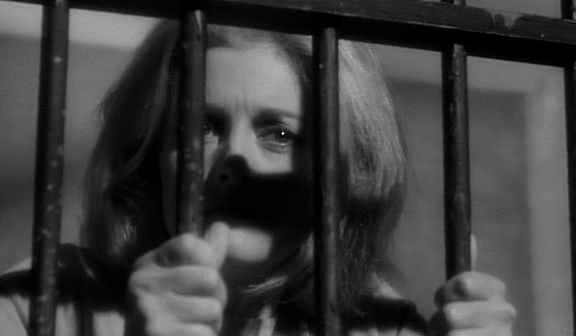A
distilled genre film fossil, there are scenes in this pre-code era picture that
parade the generic summary of what the Women’s Prison Film is.
1933
is the year of two Barbara Stanwyck-driven productions bearing Stanwyck as a
female anti-heroine involved in crime. She plays a criminal in Ladies They Talk About; her character in
Baby Face (the majestic film that spawned this majestic
gifset) starts out in the speakeasy scene and, after Stanwyck’s character
catches up on some Nietzsche, goes on to become a 20th century Manon Lescaut minus the fatal end.
In
Ladies They Talk About Stanwyck plays
a hustler/bank robber and actually is incarcerated in a women’s penitentiary
for a good stretch of the film. The most generic, undiluted genre moments are
the raunchy scenes in which Nan (Stanwyck) first enters the prison. They are
everything a Women’s Prison Film calls for.
Wide
shots of the bustling daily grind of prison life are followed by an
introduction to typical Women in Prison Film archetypes. We witness two women fighting
over a chair, one in Spanish and the other in English; we later learn that the
English speaker is “Aunt Maggie”, who “watches out for the girls” (archetype of
the Mama character). Stanwyck’s character upon entering this fishbowl of a world is called “New
Fish”. Though tougher than the usual WPF’s protagonist, she subsequently makes
her mandatory faux-pas by impulsively
changing the channel on the radio.
The
scene is effectively underscored by a tune that we assume is non-diegetic but
suddenly realize to be coming from a radio, throwing the shallow attempt at
normalcy in prison life right in the viewer’s face.
Nan
is tough, and she makes friends just as quickly as she makes enemies (unlike
most protagonists of WPF’s melodramas). She is quickly shown around the prison
by a fellow inmate: the sunyard -“You’ll have a nickname for every blade of
grass before you get out.”
cells,
smoking/bathroom, matrons (“Second matron: okay if you are but don’t cross ‘er.”) - the sense of threat is supposed to linger.
We see women of various ages, races, and
social backgrounds; for some of them, we receive an anecdote of their former
lives (a narrative perk we’ve since, and most prominently, seen employed in
2013 streaming phenomenon Orange is the
New Black):
“Dear Mrs Arlington was a little jealous
of a certain Mrs Banks, so she gave her dinner in Mrs Banks’ honor and ground
up some of her finest glassware in Mrs Banks’ caviar, hah hah oh dear.”
or
“This little cream puff met a guy for
dinner one night and wanted to know what his name was, so she shot him and read
it in the morning papers.”
Being
a pre-code film, we get to hear Aunt Maggie talking about a policeman getting a
“manicure” in her former “beauty parlor”. There is even a butch character –
another archetype - smoking in the bathroom: “watch out for her, she likes to wrestle.”
The
appeal of the genre is immediately understood:
1.
Women,
everywhere – you will never see a more diverse crowd of women as large as this
in any movie but the women’s prison film and that’s just how it is.
The criminal angle to every story behind
every character amplifies the suspense and allure of these women, and it is
probably one of the most interesting assets of the WPF: crime is what makes a
narrative interesting; I’d even like to say: crime is always interesting.
2.
The
allure of the microcosmic guarded alternative world with its own rules and
regulations. This can be applied to anything. It’s the simple reason why the Harry Potter books are so addictive.
3.
The
closer the space, the more exciting it gets. Sparse interiors and scenery of
prison also give rise to interesting detail, invention, and character.
4.
The
satisfaction of watching a female protagonist go through alienation and toughen
up or deal with the toughness thrown at her. Power struggles and underdogs are essential
to excitement.













